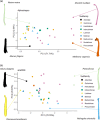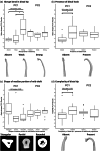Baculum shape complexity correlates to metrics of post-copulatory sexual selection in Musteloidea
- PMID: 36806148
- PMCID: PMC10952176
- DOI: 10.1002/jmor.21572
Baculum shape complexity correlates to metrics of post-copulatory sexual selection in Musteloidea
Abstract
The penis bone, or baculum, is present in many orders of mammals, although its function is still relatively unknown, mainly due to the challenges with studying the baculum in vivo. Suggested functions include increasing vaginal friction, prolonging intromission and inducing ovulation. Since it is difficult to study baculum function directly, functional morphology can give important insights. Shape complexity techniques, in particular, are likely to offer a useful metric of baculum morphology, especially since finding homologous landmarks on such a structure is challenging. This study focuses on measuring baculum shape complexity in the Musteloidea-a large superfamily spanning a range of body sizes with well-developed, qualitatively diverse bacula. We compared two shape complexity metrics-alpha shapes and ariaDNE and conducted analyses over a range of six different coefficients, or bandwidths, in 32 species of Musteloidea. Overall, we found that shape complexity, especially at the baculum distal tip, is associated with intromission duration using both metrics. These complexities can include hooks, bifurcations and other additional projections. In addition, alpha shapes complexity was also associated with relative testes mass. These results suggest that post-copulatory mechanisms of sexual selection are probably driving the evolution of more complex-shaped bacula tips in Musteloidea and are likely to be especially involved in increasing intromission duration during copulation.
Keywords: Musteloidea; baculum; evolution; genitalia; sexual selection; shape complexity.
© 2023 The Authors. Journal of Morphology published by Wiley Periodicals LLC.
Conflict of interest statement
The authors declare no conflict of interest.
Figures



Similar articles
-
Postcopulatory sexual selection and the evolution of shape complexity in the carnivoran baculum.Proc Biol Sci. 2020 Oct 14;287(1936):20201883. doi: 10.1098/rspb.2020.1883. Epub 2020 Oct 14. Proc Biol Sci. 2020. PMID: 33049172 Free PMC article.
-
Testing hypotheses for the function of the carnivoran baculum using finite-element analysis.Proc Biol Sci. 2018 Sep 19;285(1887):20181473. doi: 10.1098/rspb.2018.1473. Proc Biol Sci. 2018. PMID: 30232157 Free PMC article.
-
Postcopulatory sexual selection influences baculum evolution in primates and carnivores.Proc Biol Sci. 2016 Dec 14;283(1844):20161736. doi: 10.1098/rspb.2016.1736. Epub 2016 Dec 14. Proc Biol Sci. 2016. PMID: 27974519 Free PMC article.
-
The evolution of human reproduction: a primatological perspective.Am J Phys Anthropol. 2007;Suppl 45:59-84. doi: 10.1002/ajpa.20734. Am J Phys Anthropol. 2007. PMID: 18046752 Review.
-
An integrative view of sexual selection in Tribolium flour beetles.Biol Rev Camb Philos Soc. 2008 May;83(2):151-71. doi: 10.1111/j.1469-185X.2008.00037.x. Biol Rev Camb Philos Soc. 2008. PMID: 18429767 Review.
Cited by
-
Genetic disruption of the baculum compromises the ability of male mice to copulate.PLoS Genet. 2025 Jul 16;21(7):e1011787. doi: 10.1371/journal.pgen.1011787. eCollection 2025 Jul. PLoS Genet. 2025. PMID: 40668861 Free PMC article.
References
-
- Abramov, A. V. (2002). Variation of he baculum structure of the Palaearctic badger (Carnivora, Mustelidae, Meles). Russian Journal of Theriology, 1(1), 57–60.
-
- Abramov, A. V. , & Baryshnikov, G. F. (2000). Geographic variation and intraspecific taxonomy of weasel Mustela nivalis (Carnivora, Mustelidae). Zoosystematica Rossica, 8(2), 365–402.
-
- André, G. I. , Firman, R. C. , & Simmons, L. W. (2020). The coevolution of male and female genitalia in a mammal: A quantitative genetic insight. Evolution, 74(7), 1558–1567. - PubMed
-
- André, G. I. , Firman, R. C. , & Simmons, L. W. (2021). The effect of baculum shape and mating behavior on mating‐induced prolactin release in female house mice. Behavioral Ecology, 32(6), 1192–1201. 10.1093/beheco/arab083 - DOI
-
- Arslan, M. F. , Haridis, A. , Rosin, P. L. , Tari, S. , Brassey, C. , Gardiner, J. D. , Genctav, A. , & Genctav, M. (2022). SHREC’21: Quantifying shape complexity. Computers & Graphics, 102, 144–153.
Publication types
MeSH terms
Associated data
Grants and funding
LinkOut - more resources
Full Text Sources

